Nursing Assignment: Chlorhexidine Bathing for CVC Infection Reduction
VerifiedAdded on 2020/03/01
|13
|3182
|64
Homework Assignment
AI Summary
This nursing assignment delves into the effectiveness of chlorhexidine bathing in reducing central venous catheter (CVC) infections. It begins with a discussion on the importance of chlorhexidine dressings in the Family Nurse Practitioner (FNP) program, highlighting their role in preventing healthcare-associated infections, particularly bloodstream infections (BSIs). The assignment formulates a PICOT question to investigate chlorhexidine bathing's impact on CVC infections in high-complexity settings and advocates for a quantitative approach to an evidence-based project, detailing survey questions and study population. It reviews a quasi-experimental study by Montecalvo et al. (2012) on chlorhexidine bathing, explaining the sampling method and its advantages and disadvantages. The assignment further contrasts quantitative and qualitative approaches in controlling and generalizing study conditions. It presents a quantitative approach to evaluate chlorhexidine bathing's effectiveness, outlining data collection and analysis methods. The assignment also explains statistical and clinical significance and concludes by applying the research findings to practical clinical settings, emphasizing the feasibility and appropriateness of chlorhexidine bathing to reduce BSI and CVC infections.
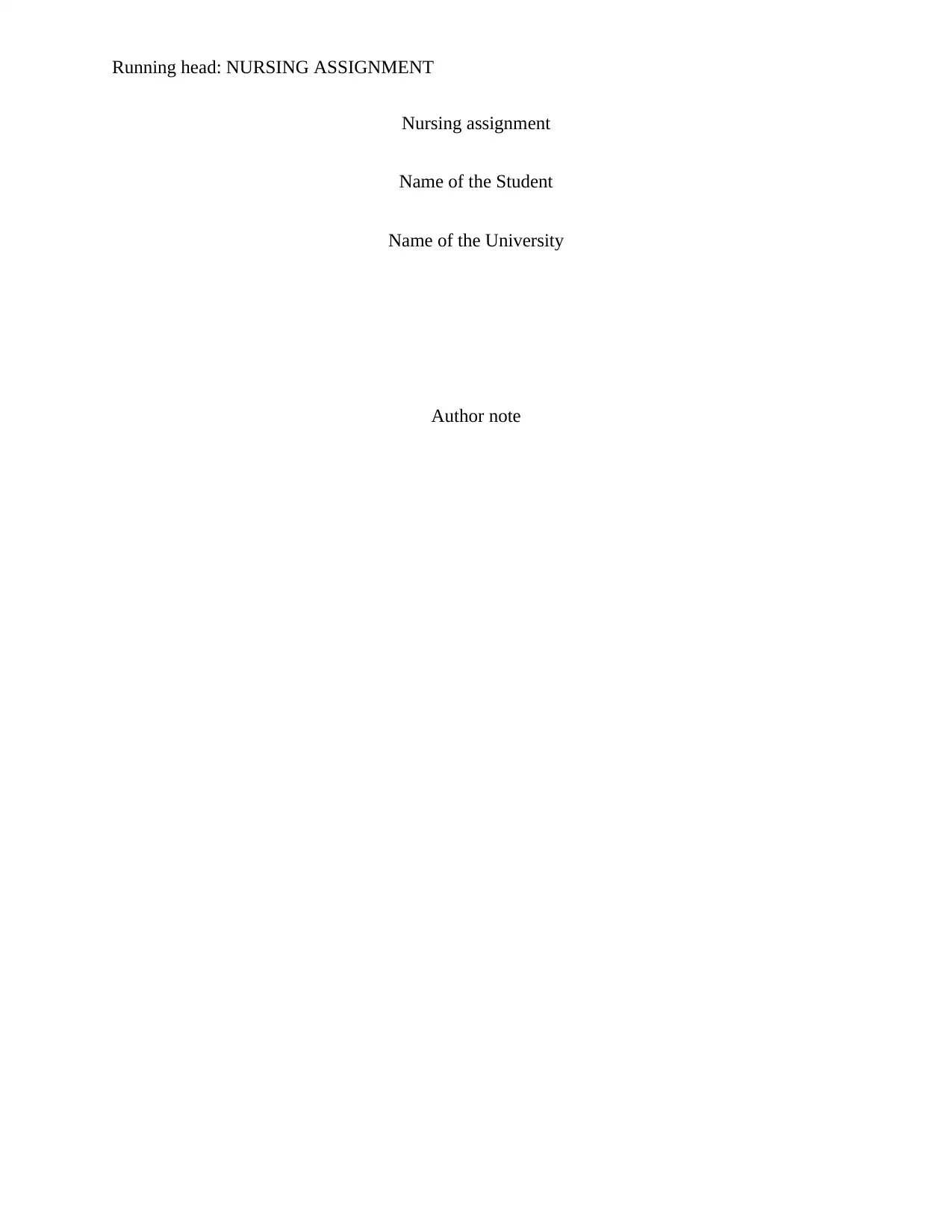
Running head: NURSING ASSIGNMENT
Nursing assignment
Name of the Student
Name of the University
Author note
Nursing assignment
Name of the Student
Name of the University
Author note
Paraphrase This Document
Need a fresh take? Get an instant paraphrase of this document with our AI Paraphraser
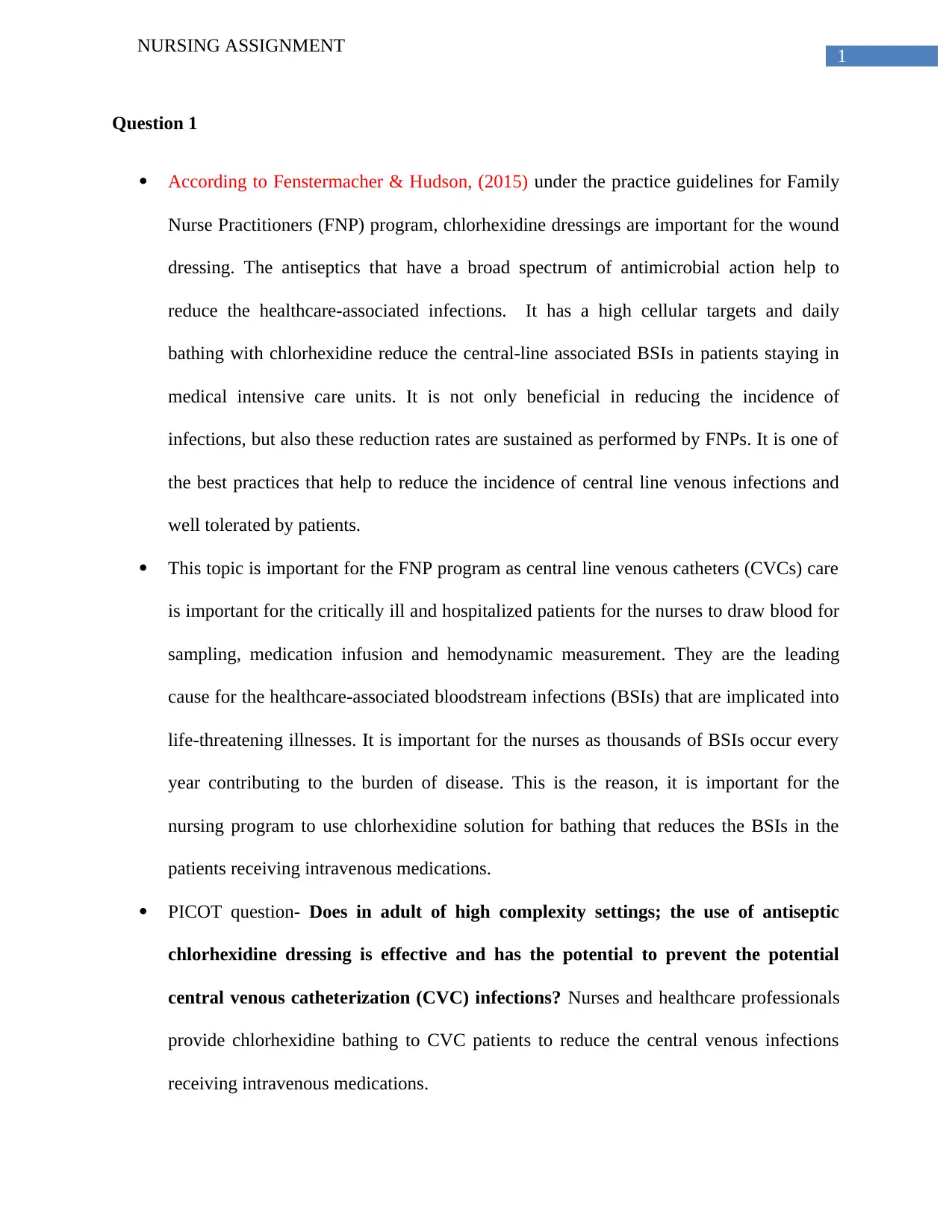
1
NURSING ASSIGNMENT
Question 1
According to Fenstermacher & Hudson, (2015) under the practice guidelines for Family
Nurse Practitioners (FNP) program, chlorhexidine dressings are important for the wound
dressing. The antiseptics that have a broad spectrum of antimicrobial action help to
reduce the healthcare-associated infections. It has a high cellular targets and daily
bathing with chlorhexidine reduce the central-line associated BSIs in patients staying in
medical intensive care units. It is not only beneficial in reducing the incidence of
infections, but also these reduction rates are sustained as performed by FNPs. It is one of
the best practices that help to reduce the incidence of central line venous infections and
well tolerated by patients.
This topic is important for the FNP program as central line venous catheters (CVCs) care
is important for the critically ill and hospitalized patients for the nurses to draw blood for
sampling, medication infusion and hemodynamic measurement. They are the leading
cause for the healthcare-associated bloodstream infections (BSIs) that are implicated into
life-threatening illnesses. It is important for the nurses as thousands of BSIs occur every
year contributing to the burden of disease. This is the reason, it is important for the
nursing program to use chlorhexidine solution for bathing that reduces the BSIs in the
patients receiving intravenous medications.
PICOT question- Does in adult of high complexity settings; the use of antiseptic
chlorhexidine dressing is effective and has the potential to prevent the potential
central venous catheterization (CVC) infections? Nurses and healthcare professionals
provide chlorhexidine bathing to CVC patients to reduce the central venous infections
receiving intravenous medications.
NURSING ASSIGNMENT
Question 1
According to Fenstermacher & Hudson, (2015) under the practice guidelines for Family
Nurse Practitioners (FNP) program, chlorhexidine dressings are important for the wound
dressing. The antiseptics that have a broad spectrum of antimicrobial action help to
reduce the healthcare-associated infections. It has a high cellular targets and daily
bathing with chlorhexidine reduce the central-line associated BSIs in patients staying in
medical intensive care units. It is not only beneficial in reducing the incidence of
infections, but also these reduction rates are sustained as performed by FNPs. It is one of
the best practices that help to reduce the incidence of central line venous infections and
well tolerated by patients.
This topic is important for the FNP program as central line venous catheters (CVCs) care
is important for the critically ill and hospitalized patients for the nurses to draw blood for
sampling, medication infusion and hemodynamic measurement. They are the leading
cause for the healthcare-associated bloodstream infections (BSIs) that are implicated into
life-threatening illnesses. It is important for the nurses as thousands of BSIs occur every
year contributing to the burden of disease. This is the reason, it is important for the
nursing program to use chlorhexidine solution for bathing that reduces the BSIs in the
patients receiving intravenous medications.
PICOT question- Does in adult of high complexity settings; the use of antiseptic
chlorhexidine dressing is effective and has the potential to prevent the potential
central venous catheterization (CVC) infections? Nurses and healthcare professionals
provide chlorhexidine bathing to CVC patients to reduce the central venous infections
receiving intravenous medications.

2
NURSING ASSIGNMENT
Question 2
Quantitative approach is the best approach for the Evidence-based project (EBP)
proposal. This approach provides information in numerical form through open and closed
ended questions in structured and unstructured interviews. Quantitative data is easy to
analyse and highly standardized (Lampard & Pole 2015). It is best for the comparison of
data in a systematic way where it tests the theories with the help of hypothesis. It is useful
for the generalization of population and compares the information in an extensive manner
(Bowling, 2014). It can be used within a specific targeted population to illuminate
meanings associated with the differences. The questionnaires and surveys can be used for
exploring the use of chlorhexidine bathing in CVC line patients in reducing infections.
PICOT question-
In critically ill patients (P), does use of chlorhexidine bathing (I), as compared to
those who do not have chlorhexidine bathing (C), aid in reducing CVC line infections (O)
in 6 months (T)?
Questions for the survey
1. What is the frequency of chlorhexidine bed-bath in CVC patients?
2. What is the duration of time bed-bath in CVC patients?
3. What cleansing agents are used for the bed-bath?
4. At what time patients are given bed-bath in ICU?
5. What are the factors like organizational and patient illness have an impact on
bed-bath in the ICUs?
NURSING ASSIGNMENT
Question 2
Quantitative approach is the best approach for the Evidence-based project (EBP)
proposal. This approach provides information in numerical form through open and closed
ended questions in structured and unstructured interviews. Quantitative data is easy to
analyse and highly standardized (Lampard & Pole 2015). It is best for the comparison of
data in a systematic way where it tests the theories with the help of hypothesis. It is useful
for the generalization of population and compares the information in an extensive manner
(Bowling, 2014). It can be used within a specific targeted population to illuminate
meanings associated with the differences. The questionnaires and surveys can be used for
exploring the use of chlorhexidine bathing in CVC line patients in reducing infections.
PICOT question-
In critically ill patients (P), does use of chlorhexidine bathing (I), as compared to
those who do not have chlorhexidine bathing (C), aid in reducing CVC line infections (O)
in 6 months (T)?
Questions for the survey
1. What is the frequency of chlorhexidine bed-bath in CVC patients?
2. What is the duration of time bed-bath in CVC patients?
3. What cleansing agents are used for the bed-bath?
4. At what time patients are given bed-bath in ICU?
5. What are the factors like organizational and patient illness have an impact on
bed-bath in the ICUs?
⊘ This is a preview!⊘
Do you want full access?
Subscribe today to unlock all pages.

Trusted by 1+ million students worldwide

3
NURSING ASSIGNMENT
The population to be studied for the study will be patients in the ICUs having variables
total days of CVC, infection rates and hospital and study period. The variable is related in
a way where they will be studied for the infection rates before and after the intervention.
Question 3
Montecalvo et al., (2012) studied the impact and sustainability of the chlorhexidine
bathing among the patients in CVC bloodstream infection using a three phases,
prospective and multi-hospital study. There were three interventions phases like pre-,
active and post intervention phases. CVC blood stream rates of infection were compared
during the study periods using Poisson’s regression.
http://www.sciencedirect.com/science/article/pii/S0002934312000149
The research design is quasi-experimental as it lacks the feature of experimental design
method like random assignment to control or treatment.
The study article represented the intervention (X) where they conducted in three different
phases. Pre, active and post intervention phases were used where they observed the
infection rates in the CVC patients (O) and data was collected through Poisson regression
(D) analysed. There was no randomised control trail in the setting. In the pre-intervention
phase, the patients were bathed with water and soap or by using non-medicated bathing
cloths. In the active intervention phase (phase 2), the patients were bathed with
chlorhexidine gluconate (2%) bathing cloths and the third phase comprised of post-
intervention phase to assess whether the chlorhexidine bathing is continued or not.
Non probability sampling was used in the research study article. Patients were selected
from respiratory and medical Intensive Care units in a tertiary Care Hospital. Sample was
NURSING ASSIGNMENT
The population to be studied for the study will be patients in the ICUs having variables
total days of CVC, infection rates and hospital and study period. The variable is related in
a way where they will be studied for the infection rates before and after the intervention.
Question 3
Montecalvo et al., (2012) studied the impact and sustainability of the chlorhexidine
bathing among the patients in CVC bloodstream infection using a three phases,
prospective and multi-hospital study. There were three interventions phases like pre-,
active and post intervention phases. CVC blood stream rates of infection were compared
during the study periods using Poisson’s regression.
http://www.sciencedirect.com/science/article/pii/S0002934312000149
The research design is quasi-experimental as it lacks the feature of experimental design
method like random assignment to control or treatment.
The study article represented the intervention (X) where they conducted in three different
phases. Pre, active and post intervention phases were used where they observed the
infection rates in the CVC patients (O) and data was collected through Poisson regression
(D) analysed. There was no randomised control trail in the setting. In the pre-intervention
phase, the patients were bathed with water and soap or by using non-medicated bathing
cloths. In the active intervention phase (phase 2), the patients were bathed with
chlorhexidine gluconate (2%) bathing cloths and the third phase comprised of post-
intervention phase to assess whether the chlorhexidine bathing is continued or not.
Non probability sampling was used in the research study article. Patients were selected
from respiratory and medical Intensive Care units in a tertiary Care Hospital. Sample was
Paraphrase This Document
Need a fresh take? Get an instant paraphrase of this document with our AI Paraphraser
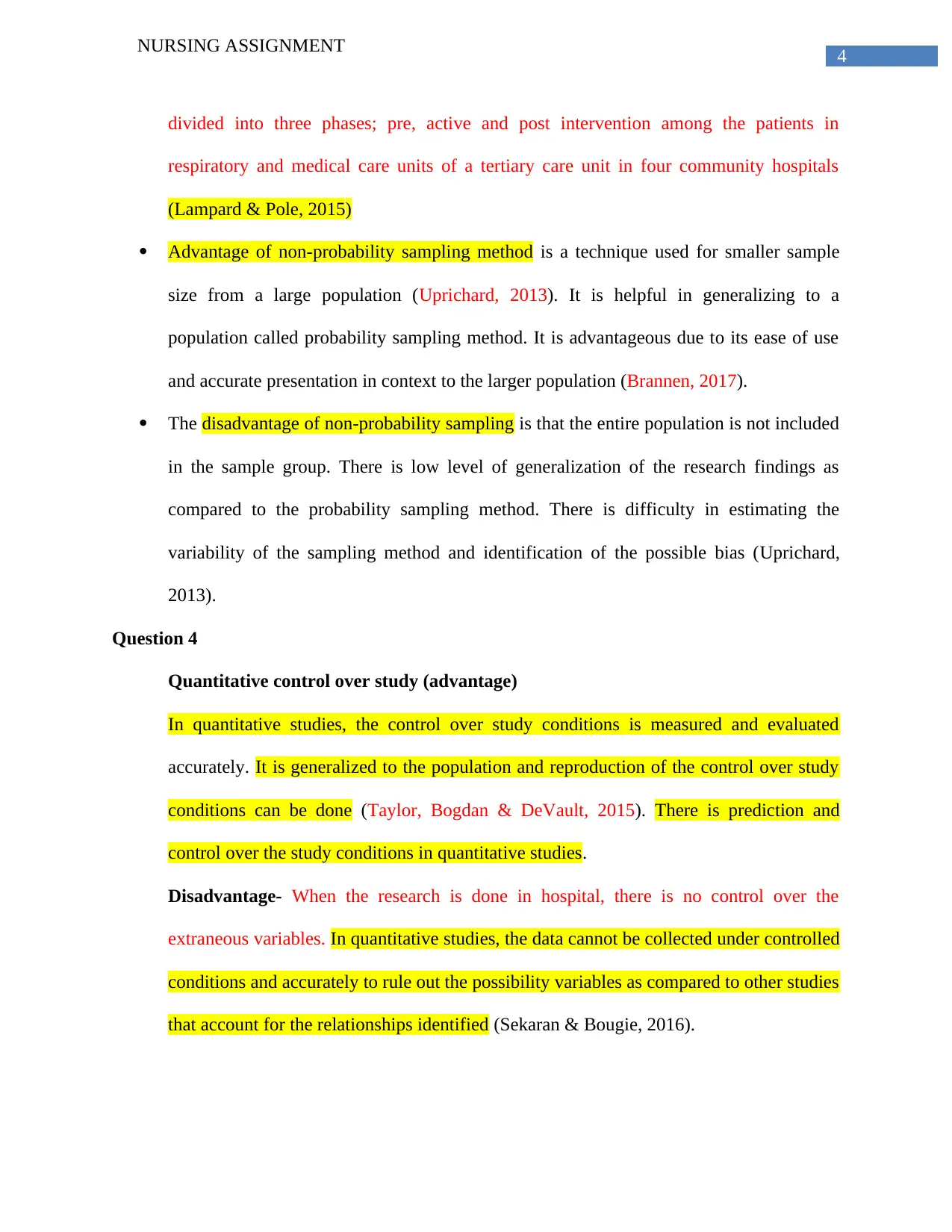
4
NURSING ASSIGNMENT
divided into three phases; pre, active and post intervention among the patients in
respiratory and medical care units of a tertiary care unit in four community hospitals
(Lampard & Pole, 2015)
Advantage of non-probability sampling method is a technique used for smaller sample
size from a large population (Uprichard, 2013). It is helpful in generalizing to a
population called probability sampling method. It is advantageous due to its ease of use
and accurate presentation in context to the larger population (Brannen, 2017).
The disadvantage of non-probability sampling is that the entire population is not included
in the sample group. There is low level of generalization of the research findings as
compared to the probability sampling method. There is difficulty in estimating the
variability of the sampling method and identification of the possible bias (Uprichard,
2013).
Question 4
Quantitative control over study (advantage)
In quantitative studies, the control over study conditions is measured and evaluated
accurately. It is generalized to the population and reproduction of the control over study
conditions can be done (Taylor, Bogdan & DeVault, 2015). There is prediction and
control over the study conditions in quantitative studies.
Disadvantage- When the research is done in hospital, there is no control over the
extraneous variables. In quantitative studies, the data cannot be collected under controlled
conditions and accurately to rule out the possibility variables as compared to other studies
that account for the relationships identified (Sekaran & Bougie, 2016).
NURSING ASSIGNMENT
divided into three phases; pre, active and post intervention among the patients in
respiratory and medical care units of a tertiary care unit in four community hospitals
(Lampard & Pole, 2015)
Advantage of non-probability sampling method is a technique used for smaller sample
size from a large population (Uprichard, 2013). It is helpful in generalizing to a
population called probability sampling method. It is advantageous due to its ease of use
and accurate presentation in context to the larger population (Brannen, 2017).
The disadvantage of non-probability sampling is that the entire population is not included
in the sample group. There is low level of generalization of the research findings as
compared to the probability sampling method. There is difficulty in estimating the
variability of the sampling method and identification of the possible bias (Uprichard,
2013).
Question 4
Quantitative control over study (advantage)
In quantitative studies, the control over study conditions is measured and evaluated
accurately. It is generalized to the population and reproduction of the control over study
conditions can be done (Taylor, Bogdan & DeVault, 2015). There is prediction and
control over the study conditions in quantitative studies.
Disadvantage- When the research is done in hospital, there is no control over the
extraneous variables. In quantitative studies, the data cannot be collected under controlled
conditions and accurately to rule out the possibility variables as compared to other studies
that account for the relationships identified (Sekaran & Bougie, 2016).
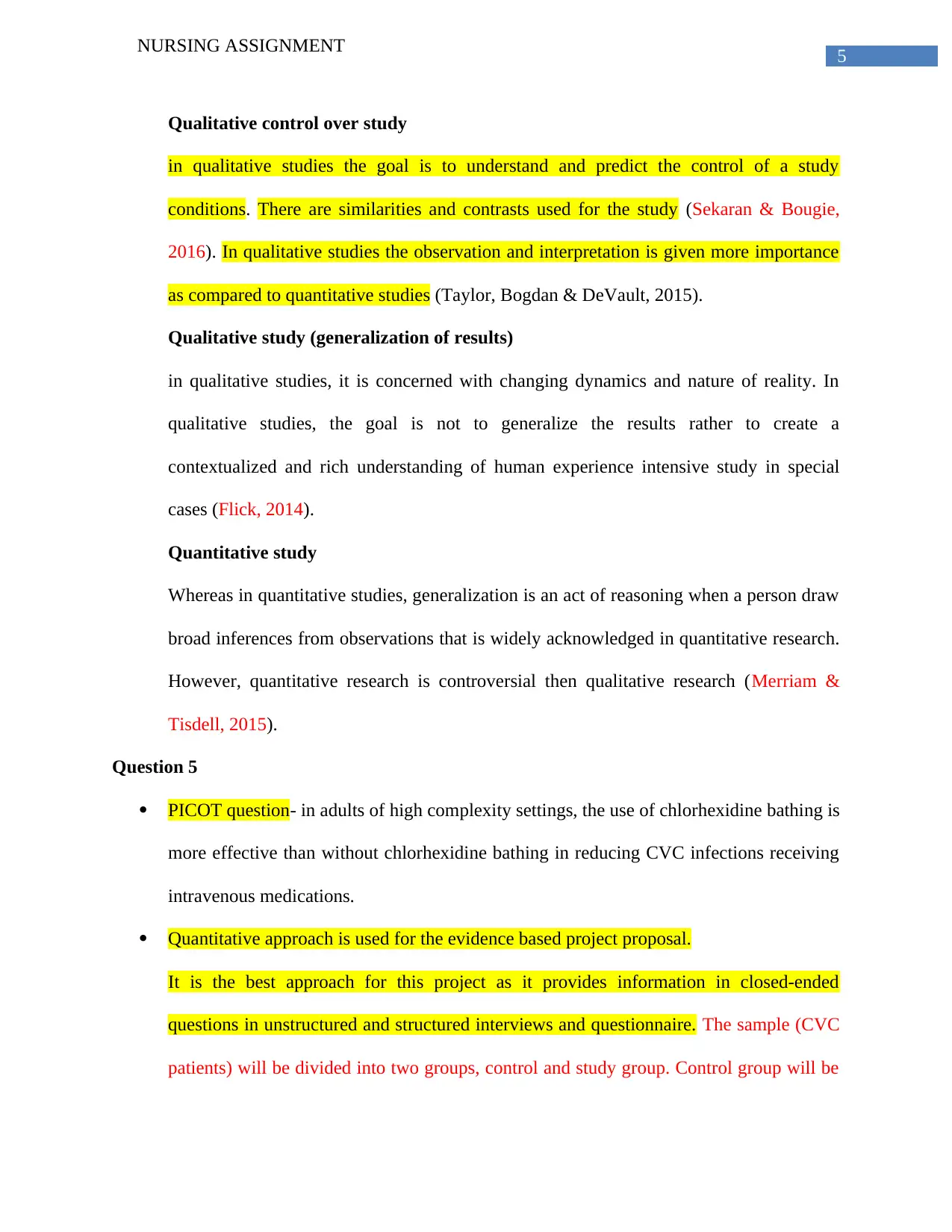
5
NURSING ASSIGNMENT
Qualitative control over study
in qualitative studies the goal is to understand and predict the control of a study
conditions. There are similarities and contrasts used for the study (Sekaran & Bougie,
2016). In qualitative studies the observation and interpretation is given more importance
as compared to quantitative studies (Taylor, Bogdan & DeVault, 2015).
Qualitative study (generalization of results)
in qualitative studies, it is concerned with changing dynamics and nature of reality. In
qualitative studies, the goal is not to generalize the results rather to create a
contextualized and rich understanding of human experience intensive study in special
cases (Flick, 2014).
Quantitative study
Whereas in quantitative studies, generalization is an act of reasoning when a person draw
broad inferences from observations that is widely acknowledged in quantitative research.
However, quantitative research is controversial then qualitative research (Merriam &
Tisdell, 2015).
Question 5
PICOT question- in adults of high complexity settings, the use of chlorhexidine bathing is
more effective than without chlorhexidine bathing in reducing CVC infections receiving
intravenous medications.
Quantitative approach is used for the evidence based project proposal.
It is the best approach for this project as it provides information in closed-ended
questions in unstructured and structured interviews and questionnaire. The sample (CVC
patients) will be divided into two groups, control and study group. Control group will be
NURSING ASSIGNMENT
Qualitative control over study
in qualitative studies the goal is to understand and predict the control of a study
conditions. There are similarities and contrasts used for the study (Sekaran & Bougie,
2016). In qualitative studies the observation and interpretation is given more importance
as compared to quantitative studies (Taylor, Bogdan & DeVault, 2015).
Qualitative study (generalization of results)
in qualitative studies, it is concerned with changing dynamics and nature of reality. In
qualitative studies, the goal is not to generalize the results rather to create a
contextualized and rich understanding of human experience intensive study in special
cases (Flick, 2014).
Quantitative study
Whereas in quantitative studies, generalization is an act of reasoning when a person draw
broad inferences from observations that is widely acknowledged in quantitative research.
However, quantitative research is controversial then qualitative research (Merriam &
Tisdell, 2015).
Question 5
PICOT question- in adults of high complexity settings, the use of chlorhexidine bathing is
more effective than without chlorhexidine bathing in reducing CVC infections receiving
intravenous medications.
Quantitative approach is used for the evidence based project proposal.
It is the best approach for this project as it provides information in closed-ended
questions in unstructured and structured interviews and questionnaire. The sample (CVC
patients) will be divided into two groups, control and study group. Control group will be
⊘ This is a preview!⊘
Do you want full access?
Subscribe today to unlock all pages.

Trusted by 1+ million students worldwide
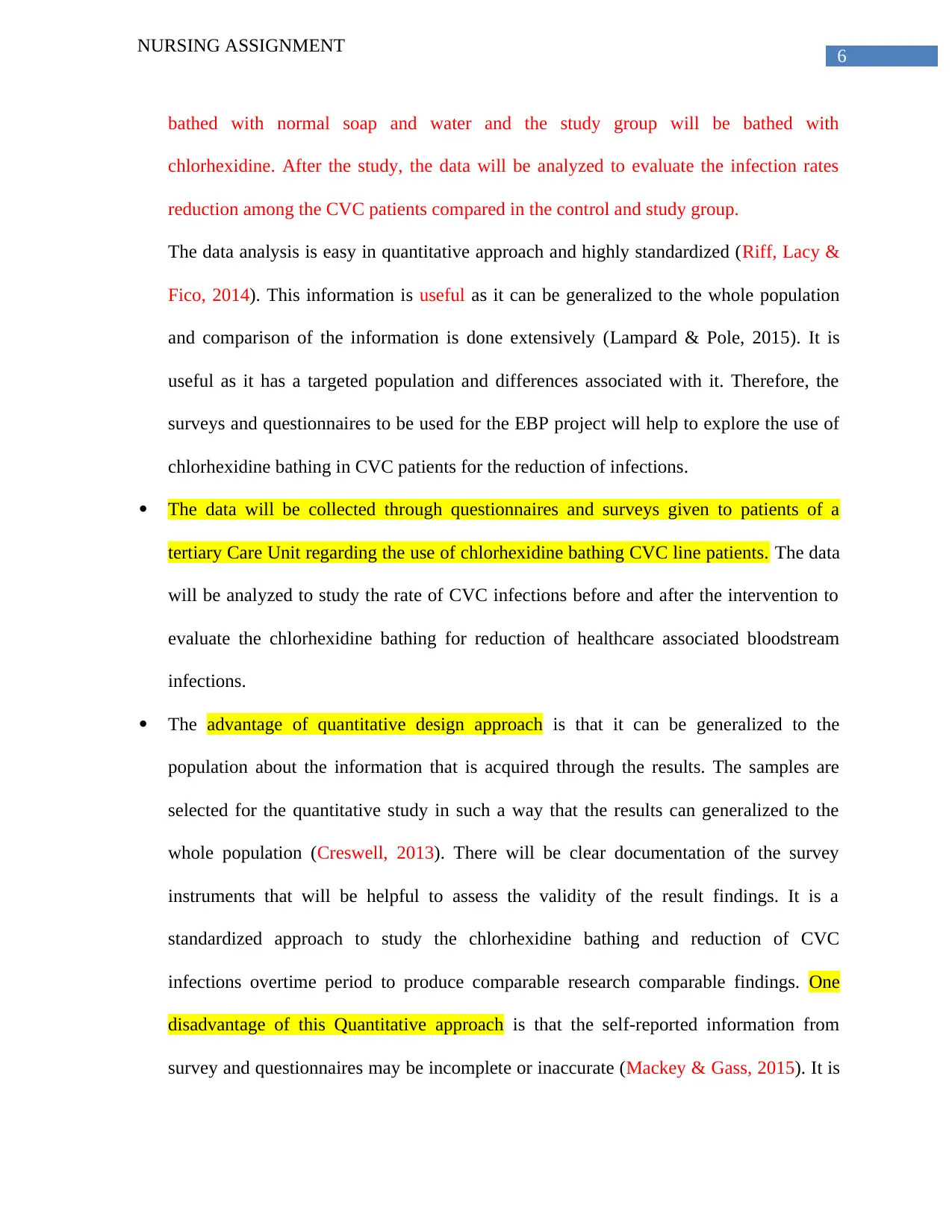
6
NURSING ASSIGNMENT
bathed with normal soap and water and the study group will be bathed with
chlorhexidine. After the study, the data will be analyzed to evaluate the infection rates
reduction among the CVC patients compared in the control and study group.
The data analysis is easy in quantitative approach and highly standardized (Riff, Lacy &
Fico, 2014). This information is useful as it can be generalized to the whole population
and comparison of the information is done extensively (Lampard & Pole, 2015). It is
useful as it has a targeted population and differences associated with it. Therefore, the
surveys and questionnaires to be used for the EBP project will help to explore the use of
chlorhexidine bathing in CVC patients for the reduction of infections.
The data will be collected through questionnaires and surveys given to patients of a
tertiary Care Unit regarding the use of chlorhexidine bathing CVC line patients. The data
will be analyzed to study the rate of CVC infections before and after the intervention to
evaluate the chlorhexidine bathing for reduction of healthcare associated bloodstream
infections.
The advantage of quantitative design approach is that it can be generalized to the
population about the information that is acquired through the results. The samples are
selected for the quantitative study in such a way that the results can generalized to the
whole population (Creswell, 2013). There will be clear documentation of the survey
instruments that will be helpful to assess the validity of the result findings. It is a
standardized approach to study the chlorhexidine bathing and reduction of CVC
infections overtime period to produce comparable research comparable findings. One
disadvantage of this Quantitative approach is that the self-reported information from
survey and questionnaires may be incomplete or inaccurate (Mackey & Gass, 2015). It is
NURSING ASSIGNMENT
bathed with normal soap and water and the study group will be bathed with
chlorhexidine. After the study, the data will be analyzed to evaluate the infection rates
reduction among the CVC patients compared in the control and study group.
The data analysis is easy in quantitative approach and highly standardized (Riff, Lacy &
Fico, 2014). This information is useful as it can be generalized to the whole population
and comparison of the information is done extensively (Lampard & Pole, 2015). It is
useful as it has a targeted population and differences associated with it. Therefore, the
surveys and questionnaires to be used for the EBP project will help to explore the use of
chlorhexidine bathing in CVC patients for the reduction of infections.
The data will be collected through questionnaires and surveys given to patients of a
tertiary Care Unit regarding the use of chlorhexidine bathing CVC line patients. The data
will be analyzed to study the rate of CVC infections before and after the intervention to
evaluate the chlorhexidine bathing for reduction of healthcare associated bloodstream
infections.
The advantage of quantitative design approach is that it can be generalized to the
population about the information that is acquired through the results. The samples are
selected for the quantitative study in such a way that the results can generalized to the
whole population (Creswell, 2013). There will be clear documentation of the survey
instruments that will be helpful to assess the validity of the result findings. It is a
standardized approach to study the chlorhexidine bathing and reduction of CVC
infections overtime period to produce comparable research comparable findings. One
disadvantage of this Quantitative approach is that the self-reported information from
survey and questionnaires may be incomplete or inaccurate (Mackey & Gass, 2015). It is
Paraphrase This Document
Need a fresh take? Get an instant paraphrase of this document with our AI Paraphraser
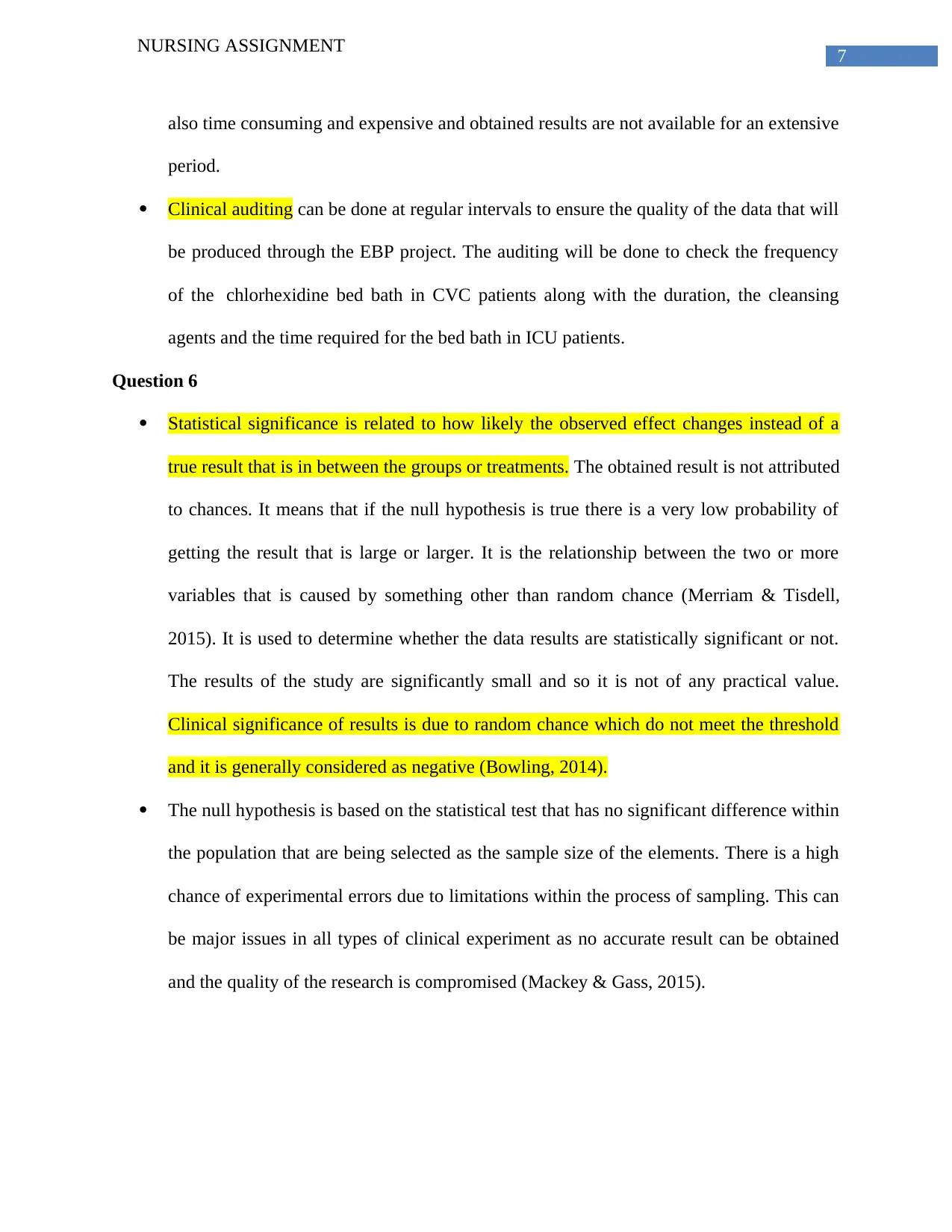
7
NURSING ASSIGNMENT
also time consuming and expensive and obtained results are not available for an extensive
period.
Clinical auditing can be done at regular intervals to ensure the quality of the data that will
be produced through the EBP project. The auditing will be done to check the frequency
of the chlorhexidine bed bath in CVC patients along with the duration, the cleansing
agents and the time required for the bed bath in ICU patients.
Question 6
Statistical significance is related to how likely the observed effect changes instead of a
true result that is in between the groups or treatments. The obtained result is not attributed
to chances. It means that if the null hypothesis is true there is a very low probability of
getting the result that is large or larger. It is the relationship between the two or more
variables that is caused by something other than random chance (Merriam & Tisdell,
2015). It is used to determine whether the data results are statistically significant or not.
The results of the study are significantly small and so it is not of any practical value.
Clinical significance of results is due to random chance which do not meet the threshold
and it is generally considered as negative (Bowling, 2014).
The null hypothesis is based on the statistical test that has no significant difference within
the population that are being selected as the sample size of the elements. There is a high
chance of experimental errors due to limitations within the process of sampling. This can
be major issues in all types of clinical experiment as no accurate result can be obtained
and the quality of the research is compromised (Mackey & Gass, 2015).
NURSING ASSIGNMENT
also time consuming and expensive and obtained results are not available for an extensive
period.
Clinical auditing can be done at regular intervals to ensure the quality of the data that will
be produced through the EBP project. The auditing will be done to check the frequency
of the chlorhexidine bed bath in CVC patients along with the duration, the cleansing
agents and the time required for the bed bath in ICU patients.
Question 6
Statistical significance is related to how likely the observed effect changes instead of a
true result that is in between the groups or treatments. The obtained result is not attributed
to chances. It means that if the null hypothesis is true there is a very low probability of
getting the result that is large or larger. It is the relationship between the two or more
variables that is caused by something other than random chance (Merriam & Tisdell,
2015). It is used to determine whether the data results are statistically significant or not.
The results of the study are significantly small and so it is not of any practical value.
Clinical significance of results is due to random chance which do not meet the threshold
and it is generally considered as negative (Bowling, 2014).
The null hypothesis is based on the statistical test that has no significant difference within
the population that are being selected as the sample size of the elements. There is a high
chance of experimental errors due to limitations within the process of sampling. This can
be major issues in all types of clinical experiment as no accurate result can be obtained
and the quality of the research is compromised (Mackey & Gass, 2015).
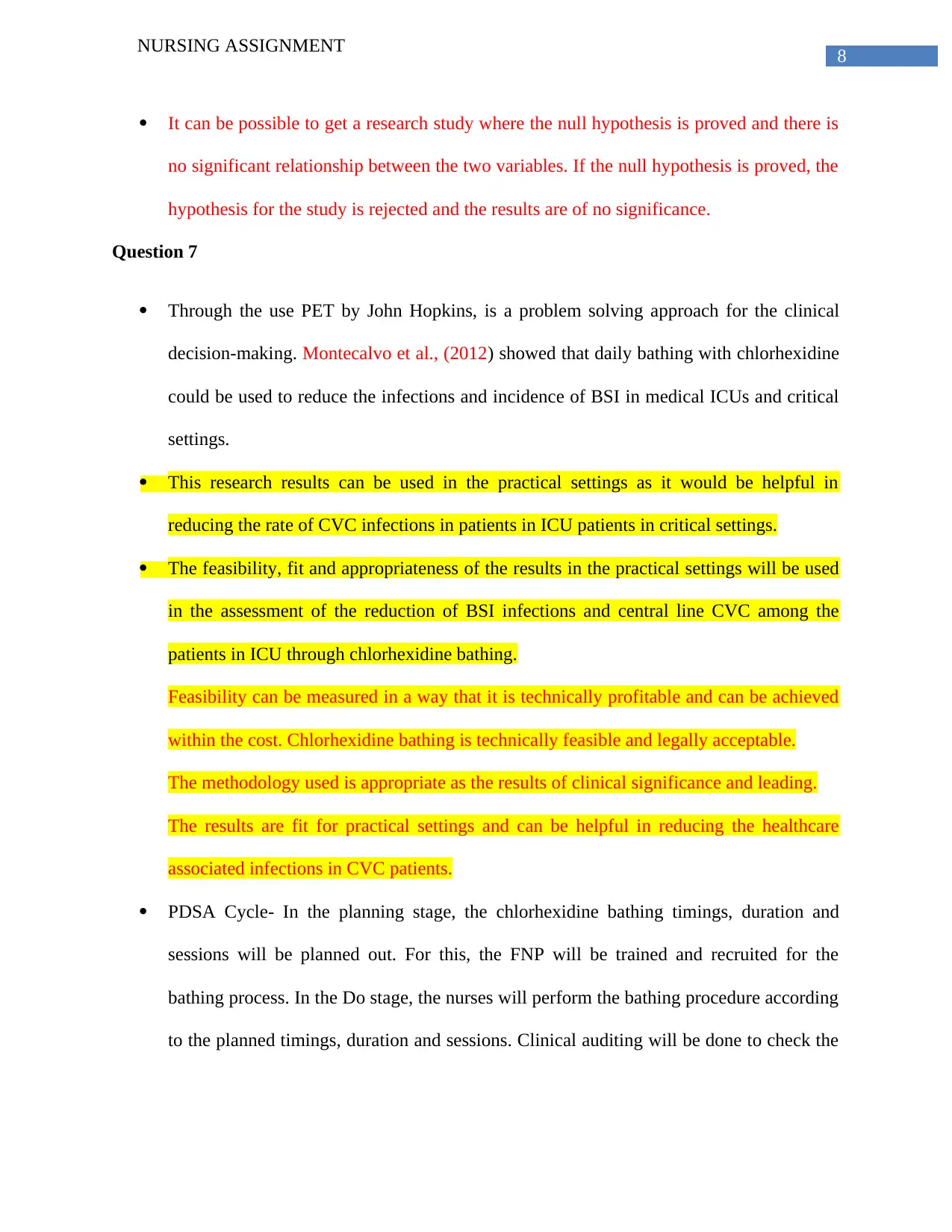
8
NURSING ASSIGNMENT
It can be possible to get a research study where the null hypothesis is proved and there is
no significant relationship between the two variables. If the null hypothesis is proved, the
hypothesis for the study is rejected and the results are of no significance.
Question 7
Through the use PET by John Hopkins, is a problem solving approach for the clinical
decision-making. Montecalvo et al., (2012) showed that daily bathing with chlorhexidine
could be used to reduce the infections and incidence of BSI in medical ICUs and critical
settings.
This research results can be used in the practical settings as it would be helpful in
reducing the rate of CVC infections in patients in ICU patients in critical settings.
The feasibility, fit and appropriateness of the results in the practical settings will be used
in the assessment of the reduction of BSI infections and central line CVC among the
patients in ICU through chlorhexidine bathing.
Feasibility can be measured in a way that it is technically profitable and can be achieved
within the cost. Chlorhexidine bathing is technically feasible and legally acceptable.
The methodology used is appropriate as the results of clinical significance and leading.
The results are fit for practical settings and can be helpful in reducing the healthcare
associated infections in CVC patients.
PDSA Cycle- In the planning stage, the chlorhexidine bathing timings, duration and
sessions will be planned out. For this, the FNP will be trained and recruited for the
bathing process. In the Do stage, the nurses will perform the bathing procedure according
to the planned timings, duration and sessions. Clinical auditing will be done to check the
NURSING ASSIGNMENT
It can be possible to get a research study where the null hypothesis is proved and there is
no significant relationship between the two variables. If the null hypothesis is proved, the
hypothesis for the study is rejected and the results are of no significance.
Question 7
Through the use PET by John Hopkins, is a problem solving approach for the clinical
decision-making. Montecalvo et al., (2012) showed that daily bathing with chlorhexidine
could be used to reduce the infections and incidence of BSI in medical ICUs and critical
settings.
This research results can be used in the practical settings as it would be helpful in
reducing the rate of CVC infections in patients in ICU patients in critical settings.
The feasibility, fit and appropriateness of the results in the practical settings will be used
in the assessment of the reduction of BSI infections and central line CVC among the
patients in ICU through chlorhexidine bathing.
Feasibility can be measured in a way that it is technically profitable and can be achieved
within the cost. Chlorhexidine bathing is technically feasible and legally acceptable.
The methodology used is appropriate as the results of clinical significance and leading.
The results are fit for practical settings and can be helpful in reducing the healthcare
associated infections in CVC patients.
PDSA Cycle- In the planning stage, the chlorhexidine bathing timings, duration and
sessions will be planned out. For this, the FNP will be trained and recruited for the
bathing process. In the Do stage, the nurses will perform the bathing procedure according
to the planned timings, duration and sessions. Clinical auditing will be done to check the
⊘ This is a preview!⊘
Do you want full access?
Subscribe today to unlock all pages.

Trusted by 1+ million students worldwide
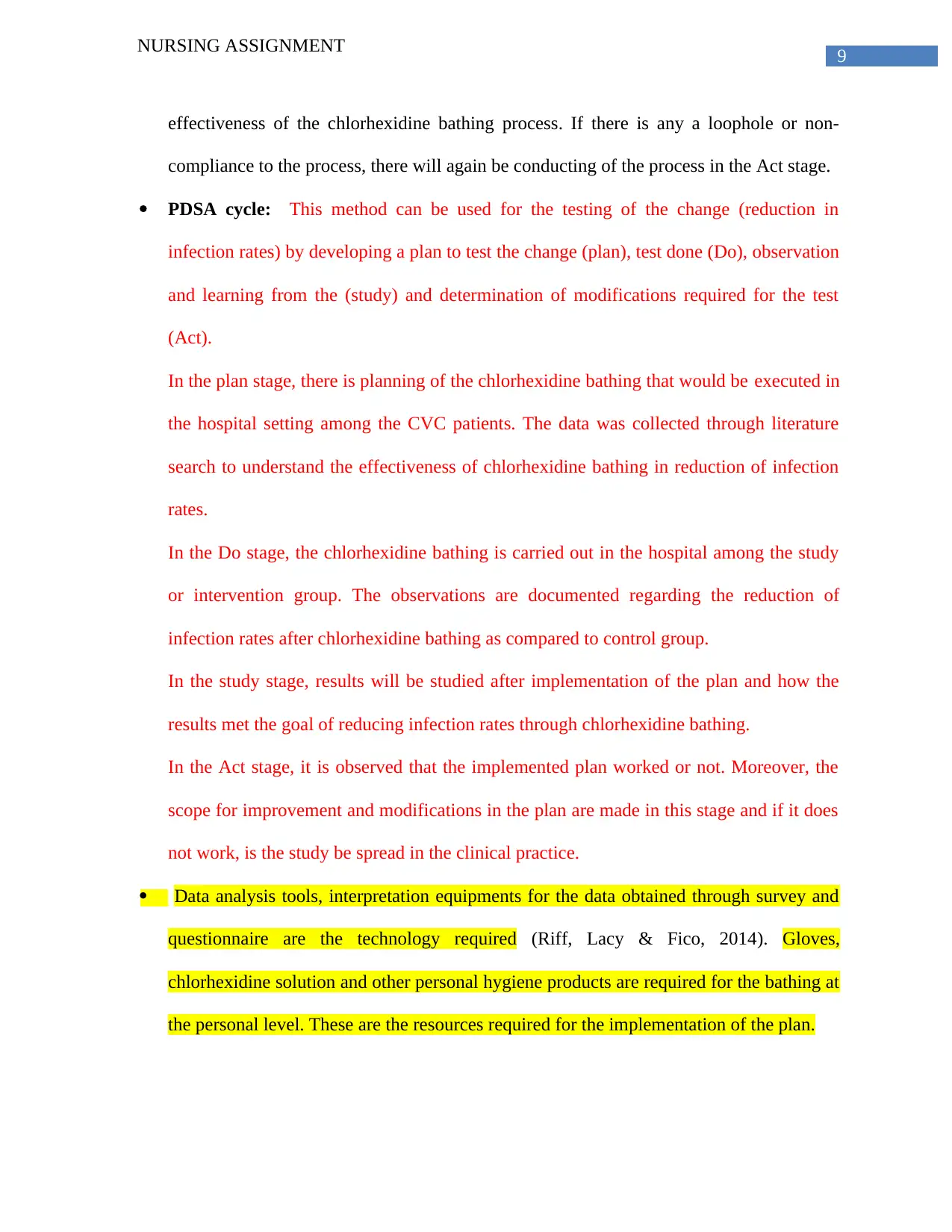
9
NURSING ASSIGNMENT
effectiveness of the chlorhexidine bathing process. If there is any a loophole or non-
compliance to the process, there will again be conducting of the process in the Act stage.
PDSA cycle: This method can be used for the testing of the change (reduction in
infection rates) by developing a plan to test the change (plan), test done (Do), observation
and learning from the (study) and determination of modifications required for the test
(Act).
In the plan stage, there is planning of the chlorhexidine bathing that would be executed in
the hospital setting among the CVC patients. The data was collected through literature
search to understand the effectiveness of chlorhexidine bathing in reduction of infection
rates.
In the Do stage, the chlorhexidine bathing is carried out in the hospital among the study
or intervention group. The observations are documented regarding the reduction of
infection rates after chlorhexidine bathing as compared to control group.
In the study stage, results will be studied after implementation of the plan and how the
results met the goal of reducing infection rates through chlorhexidine bathing.
In the Act stage, it is observed that the implemented plan worked or not. Moreover, the
scope for improvement and modifications in the plan are made in this stage and if it does
not work, is the study be spread in the clinical practice.
Data analysis tools, interpretation equipments for the data obtained through survey and
questionnaire are the technology required (Riff, Lacy & Fico, 2014). Gloves,
chlorhexidine solution and other personal hygiene products are required for the bathing at
the personal level. These are the resources required for the implementation of the plan.
NURSING ASSIGNMENT
effectiveness of the chlorhexidine bathing process. If there is any a loophole or non-
compliance to the process, there will again be conducting of the process in the Act stage.
PDSA cycle: This method can be used for the testing of the change (reduction in
infection rates) by developing a plan to test the change (plan), test done (Do), observation
and learning from the (study) and determination of modifications required for the test
(Act).
In the plan stage, there is planning of the chlorhexidine bathing that would be executed in
the hospital setting among the CVC patients. The data was collected through literature
search to understand the effectiveness of chlorhexidine bathing in reduction of infection
rates.
In the Do stage, the chlorhexidine bathing is carried out in the hospital among the study
or intervention group. The observations are documented regarding the reduction of
infection rates after chlorhexidine bathing as compared to control group.
In the study stage, results will be studied after implementation of the plan and how the
results met the goal of reducing infection rates through chlorhexidine bathing.
In the Act stage, it is observed that the implemented plan worked or not. Moreover, the
scope for improvement and modifications in the plan are made in this stage and if it does
not work, is the study be spread in the clinical practice.
Data analysis tools, interpretation equipments for the data obtained through survey and
questionnaire are the technology required (Riff, Lacy & Fico, 2014). Gloves,
chlorhexidine solution and other personal hygiene products are required for the bathing at
the personal level. These are the resources required for the implementation of the plan.
Paraphrase This Document
Need a fresh take? Get an instant paraphrase of this document with our AI Paraphraser

10
NURSING ASSIGNMENT
Clinical auditing can be performed before and after the completion of the project that will
help to determine the implementation of the project and its success (Bernard, Wutich &
Ryan, 2016). There should be periodic clinical auditing to measure the practice of
chlorhexidine bathing to reduce infection rates.
The future study of the research will be to examine the daily CHG bathing efficacy in
non-ICU patients at risk for the BSIs. It also provide scope for determining the optimal
frequency, application method and concentration required to produce comparative results
in regard to other prevention methods for reducing BSIs.
NURSING ASSIGNMENT
Clinical auditing can be performed before and after the completion of the project that will
help to determine the implementation of the project and its success (Bernard, Wutich &
Ryan, 2016). There should be periodic clinical auditing to measure the practice of
chlorhexidine bathing to reduce infection rates.
The future study of the research will be to examine the daily CHG bathing efficacy in
non-ICU patients at risk for the BSIs. It also provide scope for determining the optimal
frequency, application method and concentration required to produce comparative results
in regard to other prevention methods for reducing BSIs.
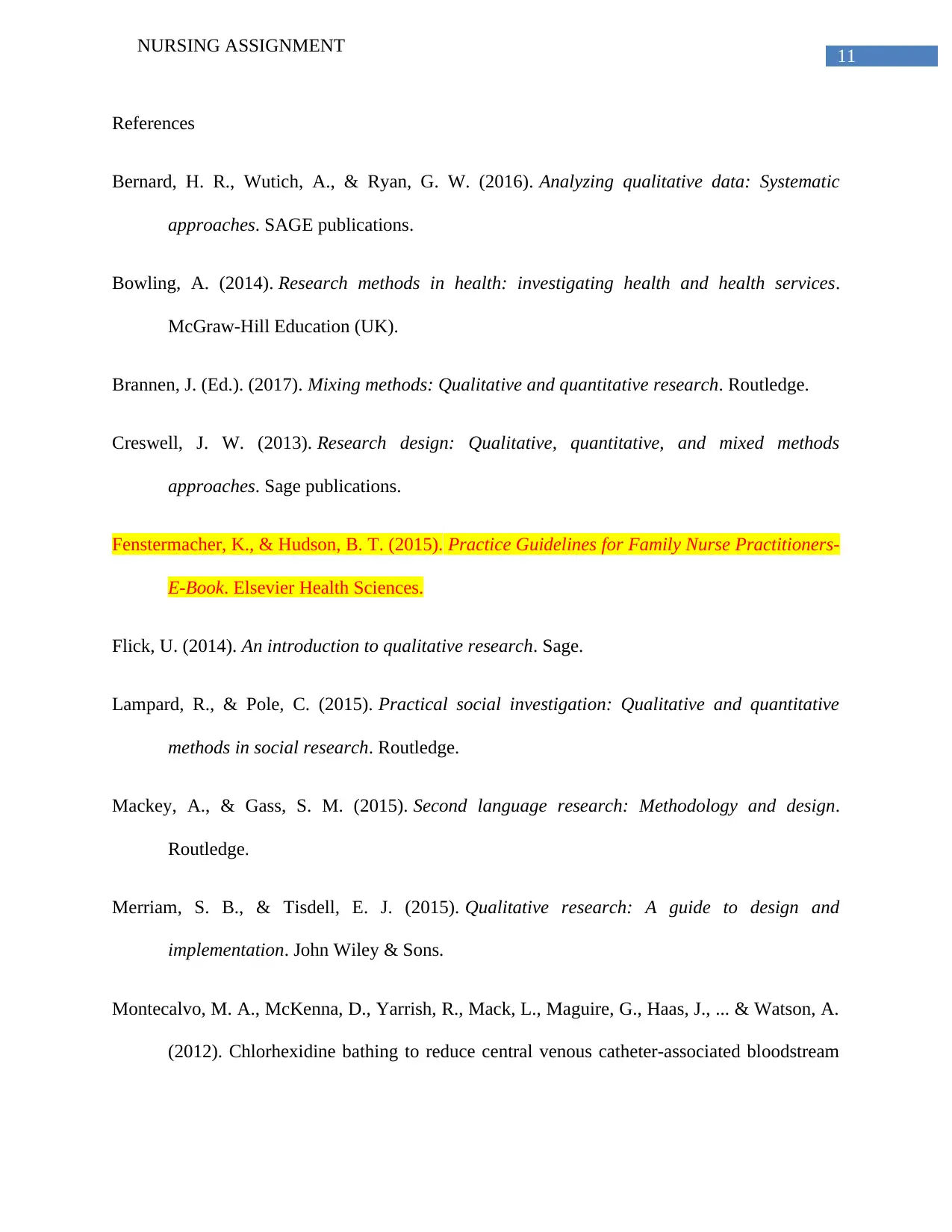
11
NURSING ASSIGNMENT
References
Bernard, H. R., Wutich, A., & Ryan, G. W. (2016). Analyzing qualitative data: Systematic
approaches. SAGE publications.
Bowling, A. (2014). Research methods in health: investigating health and health services.
McGraw-Hill Education (UK).
Brannen, J. (Ed.). (2017). Mixing methods: Qualitative and quantitative research. Routledge.
Creswell, J. W. (2013). Research design: Qualitative, quantitative, and mixed methods
approaches. Sage publications.
Fenstermacher, K., & Hudson, B. T. (2015). Practice Guidelines for Family Nurse Practitioners-
E-Book. Elsevier Health Sciences.
Flick, U. (2014). An introduction to qualitative research. Sage.
Lampard, R., & Pole, C. (2015). Practical social investigation: Qualitative and quantitative
methods in social research. Routledge.
Mackey, A., & Gass, S. M. (2015). Second language research: Methodology and design.
Routledge.
Merriam, S. B., & Tisdell, E. J. (2015). Qualitative research: A guide to design and
implementation. John Wiley & Sons.
Montecalvo, M. A., McKenna, D., Yarrish, R., Mack, L., Maguire, G., Haas, J., ... & Watson, A.
(2012). Chlorhexidine bathing to reduce central venous catheter-associated bloodstream
NURSING ASSIGNMENT
References
Bernard, H. R., Wutich, A., & Ryan, G. W. (2016). Analyzing qualitative data: Systematic
approaches. SAGE publications.
Bowling, A. (2014). Research methods in health: investigating health and health services.
McGraw-Hill Education (UK).
Brannen, J. (Ed.). (2017). Mixing methods: Qualitative and quantitative research. Routledge.
Creswell, J. W. (2013). Research design: Qualitative, quantitative, and mixed methods
approaches. Sage publications.
Fenstermacher, K., & Hudson, B. T. (2015). Practice Guidelines for Family Nurse Practitioners-
E-Book. Elsevier Health Sciences.
Flick, U. (2014). An introduction to qualitative research. Sage.
Lampard, R., & Pole, C. (2015). Practical social investigation: Qualitative and quantitative
methods in social research. Routledge.
Mackey, A., & Gass, S. M. (2015). Second language research: Methodology and design.
Routledge.
Merriam, S. B., & Tisdell, E. J. (2015). Qualitative research: A guide to design and
implementation. John Wiley & Sons.
Montecalvo, M. A., McKenna, D., Yarrish, R., Mack, L., Maguire, G., Haas, J., ... & Watson, A.
(2012). Chlorhexidine bathing to reduce central venous catheter-associated bloodstream
⊘ This is a preview!⊘
Do you want full access?
Subscribe today to unlock all pages.

Trusted by 1+ million students worldwide
1 out of 13
Related Documents
Your All-in-One AI-Powered Toolkit for Academic Success.
+13062052269
info@desklib.com
Available 24*7 on WhatsApp / Email
![[object Object]](/_next/static/media/star-bottom.7253800d.svg)
Unlock your academic potential
Copyright © 2020–2025 A2Z Services. All Rights Reserved. Developed and managed by ZUCOL.





